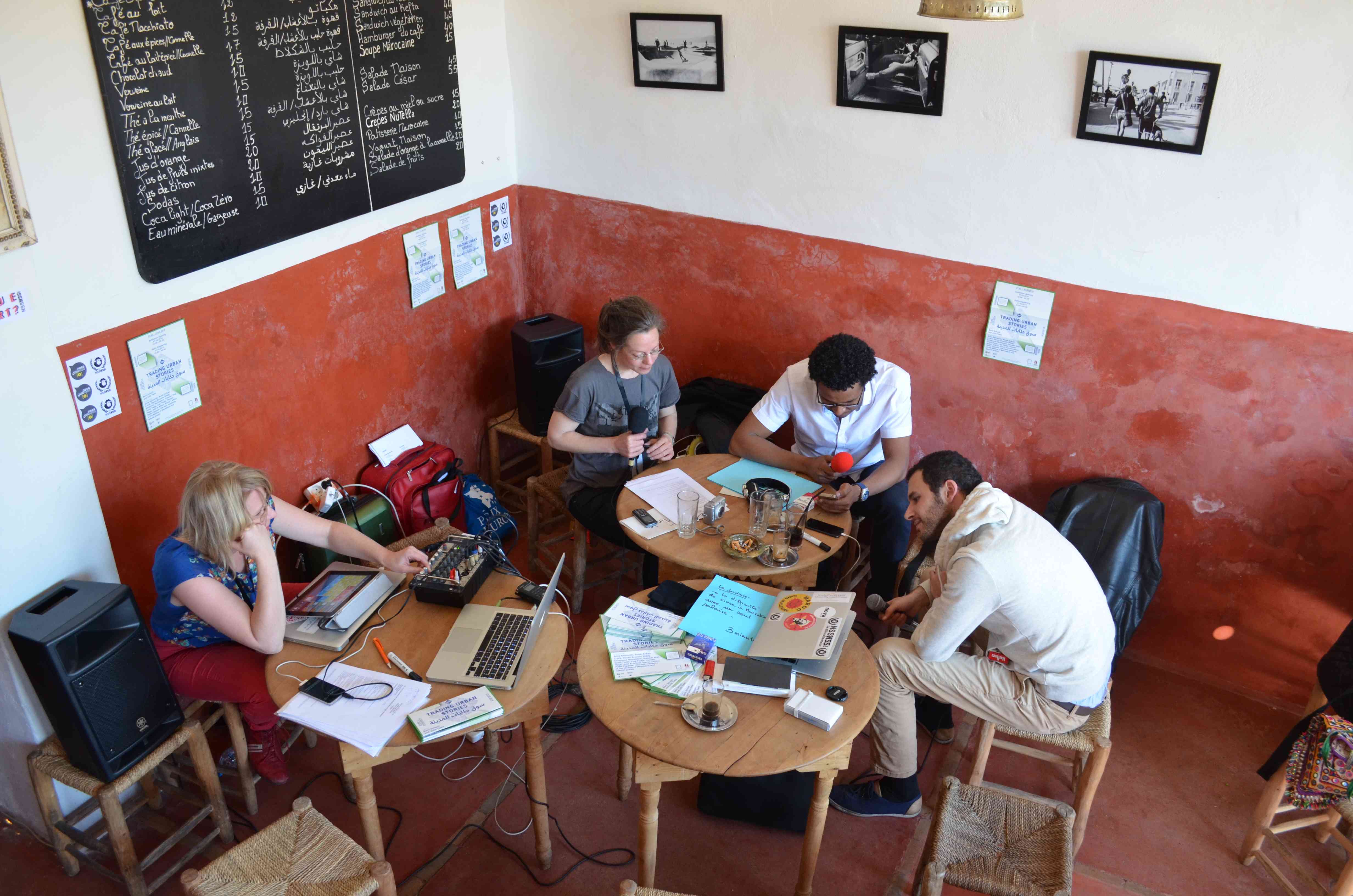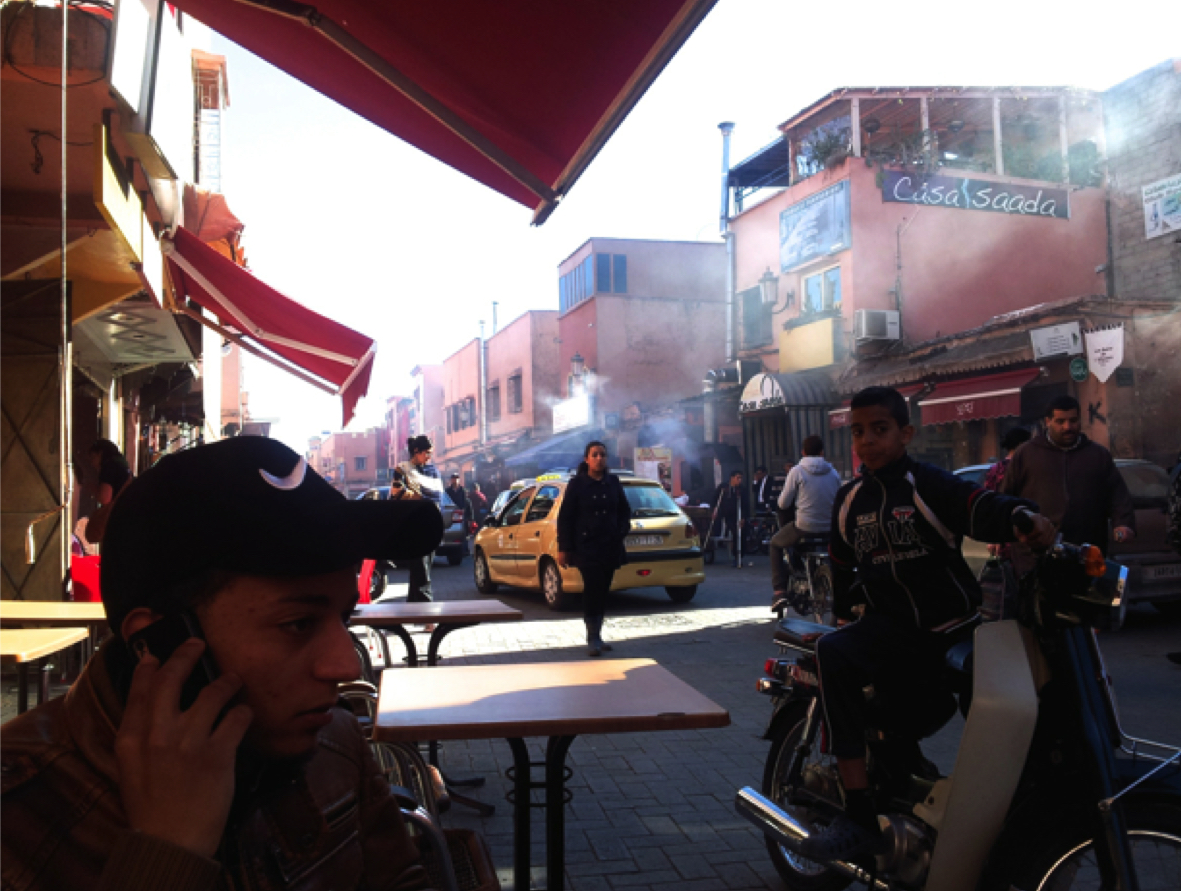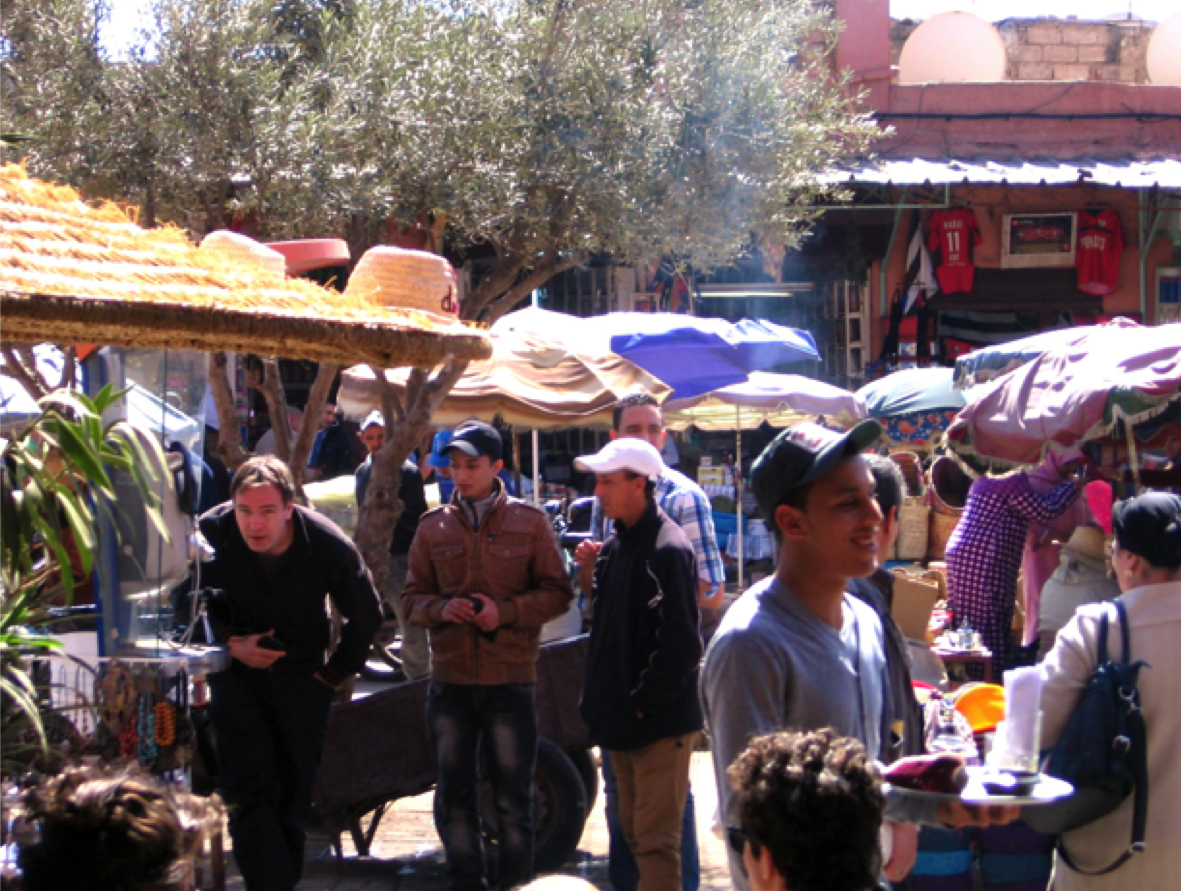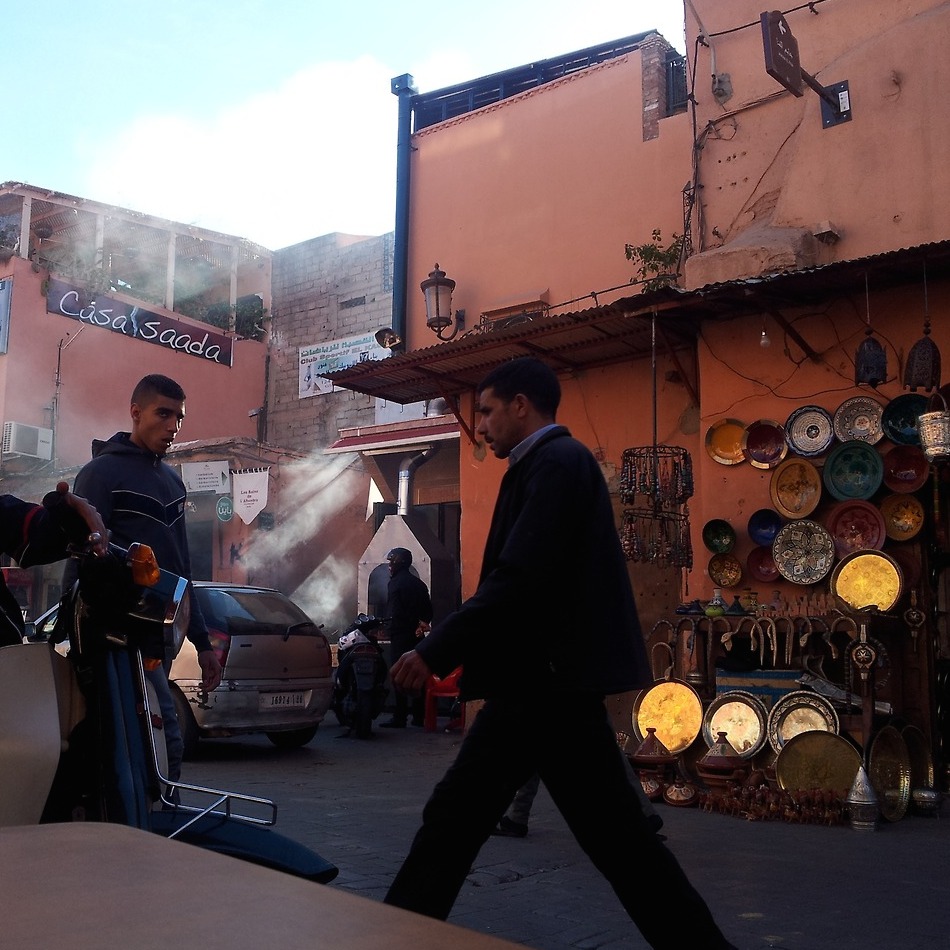After Alexandria and Beirut, Tieke and Schuck turned their ears towards Marrakech
2012’s Alexandria Streets Project saw German audio enthusiasts Julia Tieke and Berit Schuck provide what they called a ‘sonic map’ of the Egyptian port city of Alexandria, consisting of 20 audio pieces broadcasted on air as well as online. This year, after a sojourn in Lebanon for Speaking of Beirut and the City is Missing, Tieke and Schuck presented the Alexandria Streets Project alongside their latest project, Trading Urban Stories at the fifth edition of the Marrakech Biennale, which featured an audio installation, a ‘networked’ storytelling space, and a live radio event, Here and Now. Voices of Marrakech.
Elaborating on the experimental range of the Alexandria Streets Project, Trading Urban Stories mixes experimental recordings – gathered from the duo’s wanderings in Marrakech’s Medina – with live conversations and features contributions by both Moroccan and international artists. REORIENT’s Chitra Kalyani recently spoke with Julia Tieke to find out how the duo has been transforming cities into sounds.
How did the Alexandria Streets Project come about? How did you two end up working together?
We were introduced to each other by a common acquaintance, who rightly supposed we’d have many interests in common – first and foremost audio, radio, and the Arab world. When the Institute for Foreign Cultural Relations (IFA) launched a call for projects, the idea to create a sonic map of Alexandria came up immediately. We then elaborated the idea and wrote a concept for the Alexandria Streets Project comprising a sonic map, a mini radio academy, and a series of public events.
And Here and Now?
Here and Now is part of Trading Urban Stories, a direct follow-up to the Alexandria Streets Project. We were invited by Alya Sebti, the Artistic Director of the fifth Marrakech Biennale to apply within the Parallel Projects programme, and were luckily selected. Trading Urban Stories is an audio installation, a networked storytelling space, and the radio happening, Here and Now. Voices of Marrakech.

Usually visuals take precedence when one visits cities. Do you hear cities?
I am very aware of the soundscape of cities, and try to exercise separating sounds from sight, as our vision influences our hearing a lot. Sounds are much less clear, and very often ambiguous when separated from their sources. Hearing cities, for me, also goes beyond the literally audible; it includes listening to stories – those told by people, those hidden, and those imagined.
What made you choose Alexandria, and now Marrakech (as well as Beirut, in between)?
We did work on Speaking of Beirut and the City is Missing last October. One thing the three cities obviously have in common is their being part of the Arab world. I have been interested in working with, and about the Middle East since a trip [I made] to Syria and Lebanon in 2009. For me, narrating these cities, sound and story-wise, is interesting on different levels. [For] one, I am curious, simply because I like these places; this is very basic. [Second], my curiosity goes beyond ‘liking’, of course. Working in and about what is perceived as the ‘Arab world’ as a European, is of course framed – historically, politically, [and] literally – by different discourses, such as Orientalism and [notions of] the ‘other’. [The region] is in this regard also a ‘contaminated’ area with its pitfalls, but [that] at the same time [is] challenging to look for and create alternative views (sonically) and stories [in]. Of course, the historic uprisings in different Arab countries [that have been taking place] since the end of 2010 make it yet more interesting, fragile, and challenging to work in.
How would you describe the voices and sounds of Alexandria, as well as those of Marrakech? How do they compare to those of other cities you’ve visited and lived in?
Describing sounds is a lengthy matter. In Marrakech, we concentrated on the Old Town (i.e. the Medina), while in Alexandria – with a population tenfold in size – we explored larger parts of the whole city. To make a very pragmatic comparison between those two very [different] places … the Medina of Marrakech is much less noisy than Alexandria; there is [particularly] less traffic noise and [many more] bird sounds. The Marrakech Medina soundscape is really marked by walls that are so thick that they also acoustically separate quiet riads (traditional houses) from busy market streets, or vice versa, a small, quiet street from a noisy private garden [marked by bird sounds] in the middle of one of these houses; doors become sonic thresholds.
Here in Marrakech, relationships between locals and foreigners are really almost exclusively shaped by tourism and its parameters. Still, many people approached the microphone when they saw it, in order to tell us something important – be it that they know all the German soccer teams, or a complaint about the tourism police

For the Alexandria Streets Project there were three main categories - place, script, and music – as well those of the future, past, and present. What was your approach in Marrakech?
In Marrakech we concentrated on the Medina, which is very much shaped by tourism. The radio happening was a 12-hour radio show [broadcasted] from the rooftop of a café in the Medina through a live stream on NessRadio … ten walking radios (smartphones and loudspeakers) [broadcast] the programme in different places in the Medina to create local public listening stations. The radio happening was such a [long] performance, exhausting the artists over 12 hours of mainly live shows with and about the Medina. We [covered] topics such as ‘the South’, ‘Sonic Marrakech’. ‘Urban Development’, etc.
How was Trading Urban Stories different from the Alexandria Streets Project in terms of working with artists?
We invited some artists to contribute to the Marrakech programme by either creating their own sonic pieces based on [their interpretations of] the city, or by being guests on the radio happening, sharing their works live and/or joining a conversation. The works are very different in their form, [although] not so much in the content or the approach. The 20 audio pieces of the Alexandria Streets Project were thoroughly edited and composed, whereas a live radio programme is not predictable and planned, but [rather] involves improvisation and surprise.
Is there anything in particular you’d like to share about your experiences in Marrakech so far?
I think Berit and I are both happy about several coincidences and positive surprises. For example, it is great that – through our radio partner, NessRadio – we found a group of young men from a popular neighbourhood in the Medina to be our ‘walking loudspeakers’ during the radio happening. They knew the Old Town extremely well, and were enthusiastic about the idea of sharing an artistic radio programme all over the city. As usual, there are mixed experiences when being with a microphone on the ground, and here in Marrakech, relationships between locals and foreigners are really almost exclusively shaped by tourism and its parameters. Still, many people approached the microphone when they saw it, in order to tell us something important – be it that they know all the German soccer teams, or a complaint about the tourism police that would arrest people who helped tourists out (e.g. to find a particular place) in exchange for a tip. This has become illegal, and a young guy told us that he regularly spends two days in prison when caught.

What can we expect to hear on Voices of Marrakech?
You should expect to hear a non-formatted, if lucky, exciting, in any case, free-spirited 12-hour radio show about a place mostly associated with very Orientalist images of trading, selling, artistry, snake-charming, storytelling, spectacles, and traditions.
What cities would you like to hear next?
I would love to take this question literally and have cities tell their own stories with their own voices. To hear Baghdad would be of great interest to me. Other than that, I think it might be interesting to work more regionally as well, in a German town or city [for example].
Radio has been a powerful medium for around 100 years. Artistic radio projects are great ways to experiment with the medium that has become mostly formatted, or even just commercial. It is communicative, and in the best sense, simple. It lets you move freely, [both] physically and mentally. Sound does not bind you to a specific place like television binds you to the sofa. You can easily travel anywhere.

